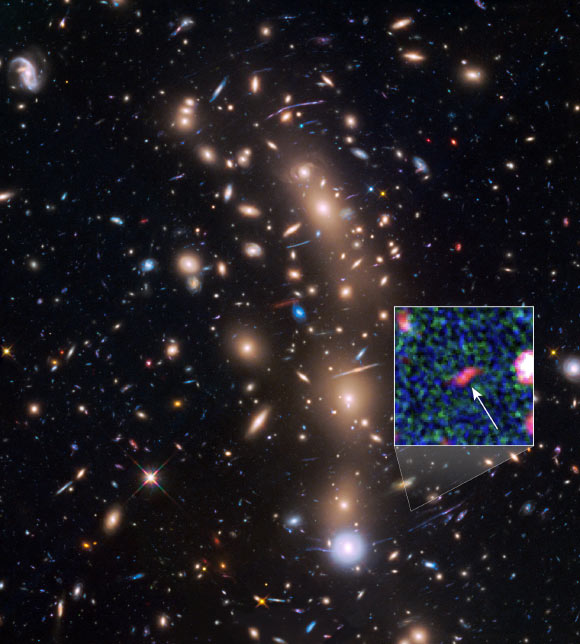Using two orbiting telescopes – the NASA/ESA Hubble Space Telescope and NASA’s Spitzer Space Telescope, astronomers have found the faintest galaxy ever seen in the early Universe. Light from this galaxy, dubbed the Tayna galaxy, left it about 400 million years after the beginning of the Universe.

This Hubble image shows a very massive cluster of galaxies, MACS J0416.1-2403, located roughly 4 billion light-years away. The inset is an image of the Tayna galaxy, an extremely faint and distant galaxy that existed only 400 million years after the Big Bang. Image credit: NASA / ESA / L. Infante, Pontificia Universidad Catolica de Chile.
The newly-discovered galaxy, the unofficial name of which means ‘first-born’ in Aymara (a language spoken in the Andes and Altiplano regions of South America), is comparable in size to the Large Magellanic Cloud.
It belongs to a class of small and faint newly-forming galaxies that until now have largely evaded detection.
According to a study published in the Astrophysical Journal (arXiv.org preprint), the Tayna galaxy is rapidly making stars at a rate 10 times faster than the Large Magellanic Cloud.
The galaxy is part of a discovery of 22 young galaxies at ancient times located nearly at the observable horizon of the Universe.
“Thanks to this detection, we have been able to study for the first time the properties of extremely faint objects formed not long after the Big Bang,” said study lead author Dr Leopoldo Infante, of the Pontifical Catholic University of Chile.
Dr Infante and his colleagues managed to capture an image of the Tayna galaxy thanks to a giant cluster of galaxies, MACS J0416.1-2403, located between Earth and this remote galaxy.
The astronomers said the cluster itself lies about 4 billion light-years away from us.
Its immense gravitational field magnifies the image of objects far behind it, in a phenomenon called gravitational lensing.
_____
Leopoldo Infante et al. 2015. Young Galaxy Candidates in the Hubble Frontier Fields. II. MACS J0416-2403. ApJ 815, 18; doi: 10.1088/0004-637X/815/1/18







